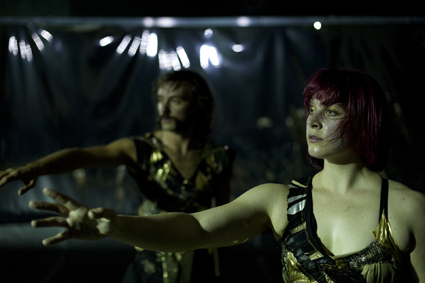between god and human
philipa rothfield: jo lloyd’s future perfect

Luke George, Madeleine Krenek, Future Perfect
photo Rohan Young
Luke George, Madeleine Krenek, Future Perfect
“…RHYTHM IS A COMPULSION; IT ENGENDERS AN UNCONQUERABLE DESIRE TO YIELD, TO JOIN IN; NOT ONLY THE STRIDE OF THE FEET BUT ALSO THE SOUL ITSELF GIVES IN TO THE BEAT—PROBABLY ALSO, ONE INFERRED, THE SOULS OF THE GODS!” FRIEDRICH NIETZSCHE, THE GAY SCIENCE
Rhythm, according to Nietzsche, can summon the gods, mould the future or elicit emotion. Like art, rhythm fabricates. It creates a temporal pulse or logic. It also compels conformity. We want to fall in with the beat. Rhythm thereby seduces. It exerts the power of inclusion.
Future Perfect begins with a beat, found and repeated by all five performers. They dance as one, producing a jiggling, ‘Brownian’ motion, a suspension of particles, shaken not stirred, as they shift weight from one foot to the other. They are light on their feet as they rebound time and again. A world of repetition is created, a feeling captured and savoured.
Future Perfect trades in feelings. It is not about dance as such. Rather, it shimmers with dreamlike ambition, recalling the ancient world of the Titans, larger than life beings who view humanity from a mythical distance. The dancers are gilded in black and gold costumes, each one a variant upon the other. Phantasmagorical yes, but, like all the Greek gods, these creatures are not that different from mortals. Future Perfect vacillates between these two poles, god-like and human. It gestures towards an atmosphere beyond that which exists, yet visibly depends upon the physical labour of its dancers.
In the midst of the dancing, a series of virtual transformations (by Rhian Hinkley) is projected into the space. The film posits a set of images, each morphing into the next. Identities become blurred as one figure gives way to another. These shifts in imagery in turn have an impact on the watching of the work, changing the perceptible qualities of the dancing towards a more imaginary texture. Who these dancers are becomes less important than their collective enunciation, their patterns, implosions and explosions. They are seen as a whole, a human cluster forming, deforming then reforming. The movement-image (film) pushes the imagery of the movement (dancing) towards a sense of metamorphosis. I let go of my focus and watch the shadows, allowing the bodies to become otherwise.
Ultimately, this imaginary freedom is reined in. The work enters a dystopic phase, a fall from grace. Bodies are less harmonious, in conflict with one another. They fall, not by giving in to gravity, more through a sense of tragedy, as if they would be better off floating. The group is more fractured, individualistic, at odds with itself. Have the immortals gone the way of all humankind? Is death the worst life has to offer?
Future Perfect ends rather abruptly (unless I missed something) which is ironic really, given the work’s title. Perhaps I was lurking in the past while Future Perfect finished. In any case, I have the feeling that narrative development is not where this piece is at. Everything points to the creation of an atmosphere. The space is hung with curvilinear curtains that produce irregular reflections. The shimmering costumes, moving images, the planetary reorientations of the group conjoin to create an ambience. At times I was inside that ambience, suspended in its imaginary ether. At other times, the mood thinned and the magic evaporated.
The strength and power of Future Perfect is found at a distance, in the slow transformations of the group, in the ways in which, together, the group becomes bigger, more than human. That distance in turn enables perception to be freer, able to stray into the neighbourhood of the imaginary. If there is more to be told at the level of human aspiration, then perception needs to find a landing place closer to home. Therein lies the tension, between the god-like and the human, between the pathos of distance and the all too proximate earth.
Future Perfect, choreographer, director Jo Lloyd, performers Luke George, Rebecca Jensen, Madeleine Krenek, Shian Law, Lily Paskas, lighting & set designer Jennifer Hector, music Duane Morrison, costumes Doyle Barrow, projection design Rhian Hinkley, Trades Hall, Melbourne, Sept 14-18
RealTime issue #106 Dec-Jan 2011 pg. 28






